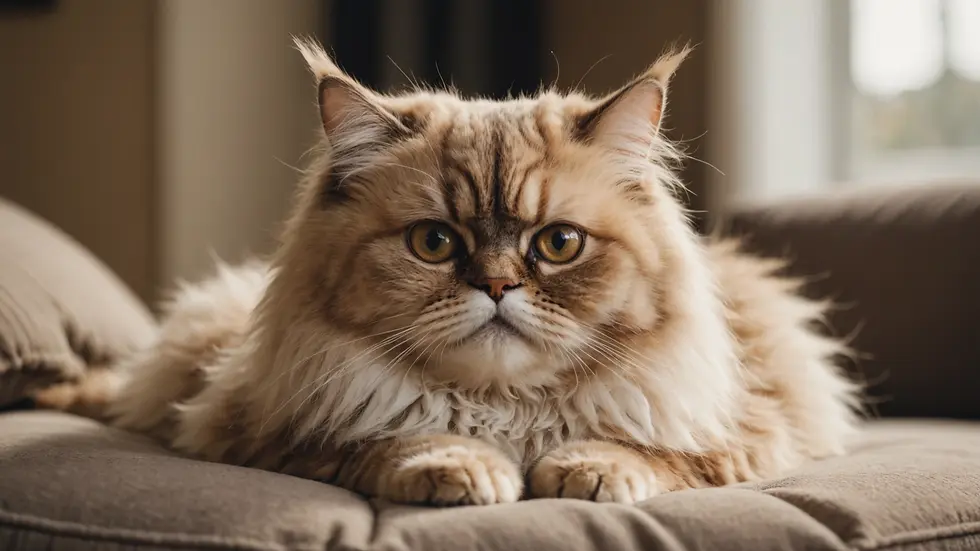How to Find the Perfect Feline Companion: Choosing the Right Cat Breed for Your Lifestyle
- Jyotiraj Borah
- Feb 5
- 5 min read
Choosing the right cat breed can be exciting yet daunting. With so many options available, each breed has its own unique traits, behaviors, and requirements that significantly impact how well they integrate into your life. Understanding what you need and want is the first step toward finding your ideal feline friend. This guide is designed to help you make an informed choice that aligns with your lifestyle and preferences.
Understanding Your Lifestyle
Before jumping into specific cat breeds, it’s vital to assess your lifestyle. Reflect on how much time you can realistically dedicate to a pet. For instance, if you work long hours or travel frequently, a low-maintenance cat may be your best fit.
Conversely, if you telecommute or have a flexible schedule, you might enjoy the company of a social and outgoing cat that thrives on interaction. A survey conducted by the American Veterinary Medical Association found that 30% of pet owners choose their pets based on their lifestyle preferences.
Activity Level Requirements
Activity levels among cat breeds can vary widely. Understanding the energy requirements of a breed can help you choose one that suits your lifestyle.
High Energy Breeds: Breeds such as the Abyssinian and Maine Coon are energetic and thrive on daily play. They require dedicated time for interaction each day, as they can become bored and restless. For example, a playful Maine Coon may need at least 30 minutes of active playtime daily.
Moderate Energy Breeds: The British Shorthair and American Shorthair enjoy a balanced mix of play and relaxation. They may appreciate a dedicated play session but are equally content lounging with you on the couch.
Low Energy Breeds: If you're looking for a cat that enjoys a slower pace, consider the Persian or Ragdoll. These breeds often enjoy resting and require less active engagement, making them ideal for quieter homes.
Grooming Needs
Grooming plays a significant role in picking the right breed. Some cats require regular grooming while others are self-sufficient.
High Grooming Needs: Breeds like the Persian and Maine Coon have long fur that necessitates frequent brushing—at least two to three times a week—to prevent knots and tangles.
Moderate Grooming Needs: The British Shorthair and Bengal usually require grooming around once a week to keep their fur healthy and shiny.
Low Grooming Needs: Short-haired breeds such as the American Shorthair need minimal grooming, often just a quick brush every few weeks. This makes them a great option for individuals looking for a low-fuss pet.

Sociability and Temperament
The temperament of a cat is crucial, especially if you have children or other pets in your home.
Very Social Breeds: Siamese and Ragdoll cats are known for their friendly and engaging behavior. They crave companionship and can show signs of loneliness if left alone for extended periods.
Moderately Social Breeds: Breeds like the Bengal and British Shorthair enjoy company but can also find comfort in solitude. They typically adapt well to various home environments.
Less Social Breeds: Some breeds, such as the American Shorthair, may enjoy human company but prefer their independence. They make good companions for those who appreciate more laid-back interactions.
Age of the Cat
When selecting a cat, consider its age. Kittens are playful and energetic, but they also require training and socialization. Adult cats in shelters often have established personalities and can fit more seamlessly into your home.
Choosing a kitten means investing time into nurturing and socializing until they mature. In contrast, older cats may offer calm companionship and better align with a busy lifestyle. According to the ASPCA, adopting an adult cat often results in less behavioral issues, as they are usually past the more troublesome kitten phase.
Compatibility with Other Pets
If you already have pets, consider how a new cat would fit into your existing family dynamic. Some breeds are more adaptable.
Great with Other Pets: Ragdolls and Burmese cats are generally friendly and integrate well with dogs and other cats. Their playful nature makes them ideal for multi-pet households.
Territorial Breeds: Some cats, like the Maine Coon, may need time to adjust to new companions, as they can be more protective of their space.

Local Environment Considerations
Your living environment is another important factor that influences your choice of cat breed. If you reside in an apartment, a more laid-back breed that doesn't require outdoor exercise may be preferable.
Think about:
Space: High-energy breeds often need room to roam and play, while more sedentary breeds might thrive in smaller living spaces.
Access to Outdoors: If you have a secure backyard, you may consider breeds that enjoy outdoor adventures, such as the adventurous Abyssinian or playful Bengal.
Health Considerations
Every cat breed has specific health challenges. Familiarizing yourself with these can help you prepare for future vet visits and potential costs.
For instance, Persians often face respiratory issues due to their flat faces, and Siamese cats can have dental problems. Researching the common health concerns associated with a breed can help you provide better care and anticipate any medical expenses.
Adoption vs. Breeder
The choice between adopting from a shelter or purchasing from a breeder is significant and can affect your breed choice. Shelters offer a range of breeds and often house cats in need of a loving home. According to the Humane Society, adopting a cat can save you money while also saving a life.
If you have a specific breed in mind, consider a reputable breeder. Ensure they practice responsible breeding and prioritize the health of their cats. Regardless of the path you choose, both have unique rewards.
Making the Final Decision
Now that you have insight into what you’re looking for, it’s time to make your choice. Consider outlining your priorities:
Assess your lifestyle and how much time you can commit to a pet.
Determine your grooming capability.
Decide if you want a sociable cat or one that is more independent.
Once you've established your priorities, you can compare various breeds and see which ones align with your needs.

Finding Your Feline Friend
Choosing the right cat breed is a journey that requires reflection on your own life and needs. By considering energy levels, grooming needs, personality traits, and health concerns, you can find a pet that fits your home perfectly.
Whether you are drawn to the playful nature of a Bengal or the calm demeanor of a Ragdoll, the companionship a cat brings into your life can be extraordinarily fulfilling. Take your time researching and evaluating your options, and soon you will welcome a furry friend who complements your lifestyle beautifully.




Commentaires